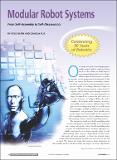| dc.contributor.author | Rus, Daniela L. | |
| dc.contributor.author | Gilpin, Kyle W. | |
| dc.date.accessioned | 2012-02-03T19:23:33Z | |
| dc.date.available | 2012-02-03T19:23:33Z | |
| dc.date.issued | 2010-09 | |
| dc.identifier.issn | 1070-9932 | |
| dc.identifier.other | INSPEC Accession Number: 11523293 | |
| dc.identifier.uri | http://hdl.handle.net/1721.1/69029 | |
| dc.description.abstract | We have presented a detailed retrospective on modular robots and discussed connections between modular robots and programmable matter. This field has seen a great deal of creativity and innovation at the level of designing physical systems capable of matching shape to function and algorithms that achieve this capability. The success of these projects rests on the convergence of innovation in hardware design and materials for creating the basic building blocks, information distribution for programming the interaction between the blocks, and control. Most current systems have dimensions on the order of centimeters, yet pack computation, communication, sensing, and power transfer capabilities into their form factors. Additionally, these modules operate using distributed algorithms that use a modules ability to observe its current neighborhood and local rules to decide what to do next. | en_US |
| dc.description.sponsorship | United States. Defense Advanced Research Projects Agency. Programmable Matter Program | en_US |
| dc.description.sponsorship | United States. Defense Advanced Research Projects Agency. Chembot Program | en_US |
| dc.description.sponsorship | United States. Army Research Office (grant W911NF-08-1-0228) | en_US |
| dc.description.sponsorship | United States. Army Research Office (grant W911NF-08-C-0060) | en_US |
| dc.description.sponsorship | National Science Foundation (U.S.). Office of Emerging Frontiers in Research and Innovation | en_US |
| dc.description.sponsorship | Intel Corporation | en_US |
| dc.description.sponsorship | National Defense Science and Engineering Graduate Fellowship | en_US |
| dc.language.iso | en_US | |
| dc.publisher | Institute of Electrical and Electronics Engineers (IEEE) | en_US |
| dc.relation.isversionof | http://dx.doi.org/10.1109/mra.2010.937859 | en_US |
| dc.rights | Article is made available in accordance with the publisher's policy and may be subject to US copyright law. Please refer to the publisher's site for terms of use. | en_US |
| dc.source | IEEE | en_US |
| dc.title | Modular Robot Systems From Self-Assembly to Self-Disassembly | en_US |
| dc.type | Article | en_US |
| dc.identifier.citation | Gilpin, Kyle, and Daniela Rus. “Modular Robot Systems.” IEEE Robotics & Automation Magazine 17.3 (2010): 38-55. Web. 3 Feb. 2012. Gilpin, Kyle, and Daniela Rus. “Modular Robot Systems.” IEEE Robotics & Automation Magazine 17.3 (2010): 38-55. Web. 3 Feb. 2012. © 2011 Institute of Electrical and Electronics Engineers | en_US |
| dc.contributor.department | Massachusetts Institute of Technology. Department of Electrical Engineering and Computer Science | en_US |
| dc.contributor.approver | Gilpin, Kyle W. | |
| dc.contributor.mitauthor | Rus, Daniela L. | |
| dc.contributor.mitauthor | Gilpin, Kyle W. | |
| dc.relation.journal | IEEE Robotics & Automation Magazine | en_US |
| dc.eprint.version | Final published version | en_US |
| dc.type.uri | http://purl.org/eprint/type/JournalArticle | en_US |
| eprint.status | http://purl.org/eprint/status/PeerReviewed | en_US |
| dspace.orderedauthors | Gilpin, Kyle; Rus, Daniela | en |
| dc.identifier.orcid | https://orcid.org/0000-0001-5473-3566 | |
| dc.identifier.orcid | https://orcid.org/0000-0002-9034-2340 | |
| mit.license | PUBLISHER_POLICY | en_US |
| mit.metadata.status | Complete | |
